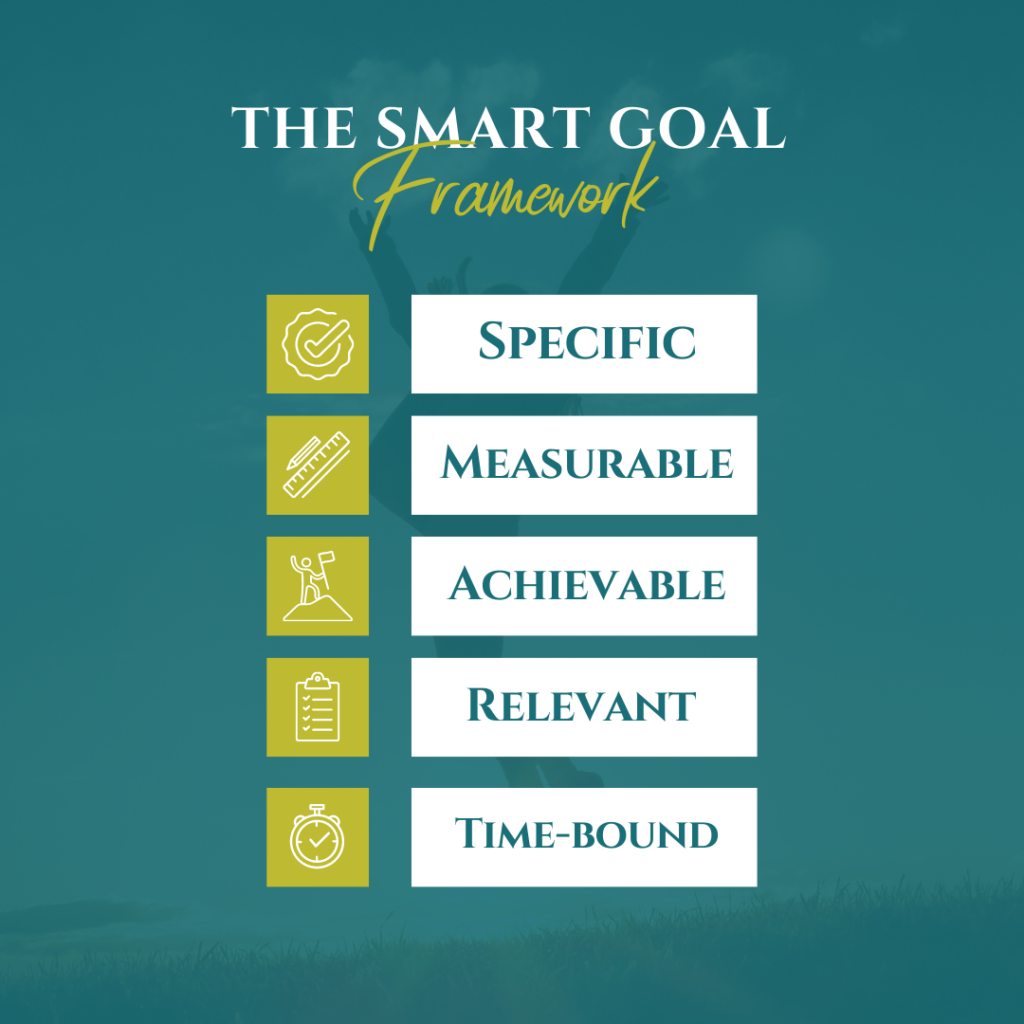Welcome Back!
Now that I’ve had a chance to introduce myself in Flourishing Fiercely’s first blog post, I’m excited to dive right in to my April blog series on a favorite topic of mine: Goals. Specifically, over the next four weeks, I’ll share why goals are important and meaningful, how to set goals, how to stay accountable and motivated to achieve your goals, and how to keep your momentum going long-term. In this post, I’ll focus on the “what,” “why,” and “how to get started” of goal-setting.

Late March/early April is a great time to revisit our resolutions and examine the difference between resolutions and goals, because we’re at the point in the year when, for many of us, our momentum and excitement around those perennial New Year’s resolutions has started to fade. If New Year’s resolutions work well for you, then great, definitely keep doing what you’re doing! But if you’re like many of us (including me!) who feel trapped in a pattern of setting resolutions every year on January 1, losing sight or losing steam on those resolutions as the coming weeks tick by and the busyness of daily life gets in the way, and then eventually breaking or giving up on our resolutions—only to feel guilty and repeat the cycle the following year—consider ditching the resolutions and focusing on goals instead!
We’re so used to breaking our resolutions, that we start to think it’s OK to try a little and then give up. It’s a mindset thing. A goal on the other hand, particularly if it’s a SMART goal (more on that in a minute), is something we believe we can reach. That makes us work a little harder and not give up on the end goal. In my experience, there are a couple of common reasons why resolutions tend to be less effective than goals.
First, resolutions often don’t have a strong connection to a “why.” Most of our New Year’s resolutions tend to revolve around a very few common themes: lose weight, exercise more, spend less, save more money, and so on. It’s understandable how this happens. The New Year’s resolution is a pretty strong cultural and consumer phenomenon in the United States, and around late December/early January we’re surrounded by ads for gym memberships or weight loss programs, for example, on TV or on social media. Similarly, the airwaves are filled with personal finance pundits lecturing us on what we “should” do with our money. Maybe we see our friends or family members making certain resolutions and we get swept along with the tide, thinking that we ought to make resolutions like those as well.
Goal-setting on the other hand, requires us to think much more critically about not only what we want to accomplish but why we want to accomplish it. As a coach, when clients start to brainstorm with me about their potential goals, one of the first things I ask is “What makes this goal important to you?” or “what’s meaningful to you about that goal?” We’re much more likely to stick with a goal if we can connect the goal to a bigger purpose that’s truly important to us (versus, for example, a resolution we set just because we felt we “should” or because other people were doing it too).
Second, resolutions tend to be pretty vague, whereas goals are specific: When do you want to quit smoking and how are you going to get there? What does it mean to you to “get in better shape”? How much money do you want to have in the bank and what do you want to save it up for?
Goals allow you to be a lot more specific. You can set attainable goals with a deadline and milestones or mini goals along the way. The SMART goal framework that I mentioned briefly above stands for:

That specificity is what helps make a goal a SMART goal. Similarly, when we consider the T (time-bound) in SMART goals, sometimes a year—the typical timeframe for a New Year’s resolution—is too long of a timeframe. Early in January we feel like we have lots and lots of time to get our act together. Then time starts to get away from us and then we find ourselves in, say, October and our goal seems impossible to reach. So what should you do instead? Be specific and attach timelines to the goals and action steps. What’s the goal you’d like to reach? Put down a number or describe what success looks like at the end of achieving that goal. When do you want to reach your goal by? It could be December 31st, but it doesn’t have to be.

After you’ve set your bigger end goal, set some mini goals along the way. To turn resolutions into reality, you need to know what you’ve got to do on a weekly or even daily basis to make it happen. And you can’t do that unless you have a set end goal. In other words, start at the end, and then figure out what it will take to get there. Let’s look at an example. Let’s say you want to get out of credit card debt this year, and you’ve used an online calculator to figure out that you’ll need to pay $300 every month in order to wipe out your whole balance (the principal plus the additional interest that will accrue throughout the year.) And by setting an end date of December 31st, you know exactly what you need to do each month to get there. From there you can work on an action plan. You could look for opportunities to pick up extra work, if possible, to generate more money to put toward that monthly payment; or take another look at your monthly budget to see if you have any discretionary expenses that you can redirect toward your payoff fund.
You may also want to do a gut-check to make sure your goal fits in with the “A” in SMART goals: Achievable. It’s great to set an ambitious goal—and often times those “stretch” goals can help us push ourselves to redefine the limits of what’s possible—but at the same time, you don’t want to set yourself up for disappointment or create a goal that’s so difficult to reach that you’ll risk giving up. For instance, not everyone’s main job or family circumstances allow them to pick up extra work hours; or perhaps you know you have a major necessary expense coming up that will require you to divert one or two months’ worth of your credit card payoff goal. Maybe it’s more achievable to set an 18-month credit card payoff goal rather than a 12-month timeline (or 12-months instead of six months, etc.) Remember: there’s no “right” or “wrong” timeline or set of action steps for your goal; you are in charge of the steps to achieve your goal and the timeframe.
If you have a big goal—for example, saving $5,000, starting a business, or changing jobs—over the coming year, check in every couple of weeks and make sure you’re still on track. If you can, and if it makes sense for the goal, get a little ahead of schedule to give yourself a buffer when things come up and get in the way of working on your action steps (illness, a vacation, a large deadline that takes up time at your job). Getting ahead of your goal schedule gives you a bit of a buffer to work with. And tracking your progress (more on that in next week’s blog post!) can help you maintain your momentum.

If you have an end date and break your goal down into monthly (or weekly or quarterly) chunks you start to see some progress. And that will keep you motivated to make it to the next milestone and then the next. Before you know it you’re getting pretty close to your goal. Doesn’t that sound like a much better strategy? Give it a try. Instead of “just” making a resolution, make a SMART goal and plan it out. It doesn’t have to take you the entire year. If you can reach your goal sooner, all the better.
Sticking with our goals—even meaningful, carefully thought-out SMART goals—can be easier said than done. Old habits are hard to break, life gets busy, stressful situations pop up, and it’s normal to struggle with motivation from time to time. We’ve all been there! Over the next three weeks, the next blog posts in my April goal-setting series will focus on tips to maintain motivation, build accountability mechanisms into your goal-achievement journey, and help set yourself up for long-term success. In the meantime, I hope this week’s post has given you a good overview of the importance of goal-setting and SMART goals. Do you have a big goal that you want to accomplish in 2023? Have you thought about ways that you can make it a SMART goal? Feel free to share with the Flourishing Fiercely community in the comments below!

